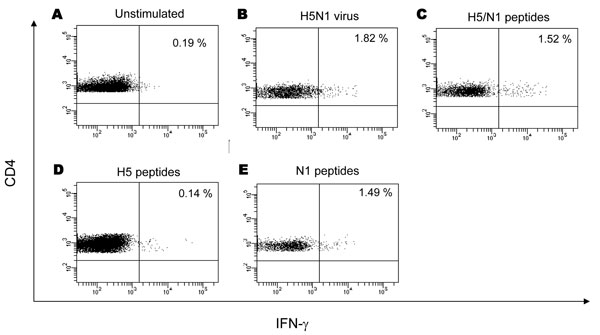Volume 14, Number 1—January 2008
Research
Cross-subtype Immunity against Avian Influenza in Persons Recently Vaccinated for Influenza
Figure 2

Figure 2. H5 versus N1 specificity of the cell-mediated response. Profiling of influenza (H5N1)–specific CD4 T-cell response in a representative study participant is shown. Peripheral blood mononuclear cells (PBMC) were expanded in vitro in the presence of interleukin-2 (IL-2) and stimulated with inactivated influenza (H5N1) virus (B), peptide pool composed by 4 peptides from H5 and N1 (C), H5 peptides (D) and N1 peptides (E). Panel A shows unstimulated cultures. Dot plots showed the presence, at similar frequency, of specific CD4 T cells when PBMC were stimulated with inactivated influenza (H5N1) virus (panel B, 1.82%), influenza (H5N1) peptides (panel C, 1.52%), and N1 peptides (panel E, 1.49%). No specific CD4 T cells producing interferon-gamma (IFN-γ) were observed after challenge with H5 peptides (D). As negative control, either mock-infected culture supernatants or irrelevant peptides were used, giving results very similar to unstimulated cultures (not shown). A similar pattern was observed in 4 other study participants, supporting the hypothesis that the actual target of cross-subtype immunity could be N1.